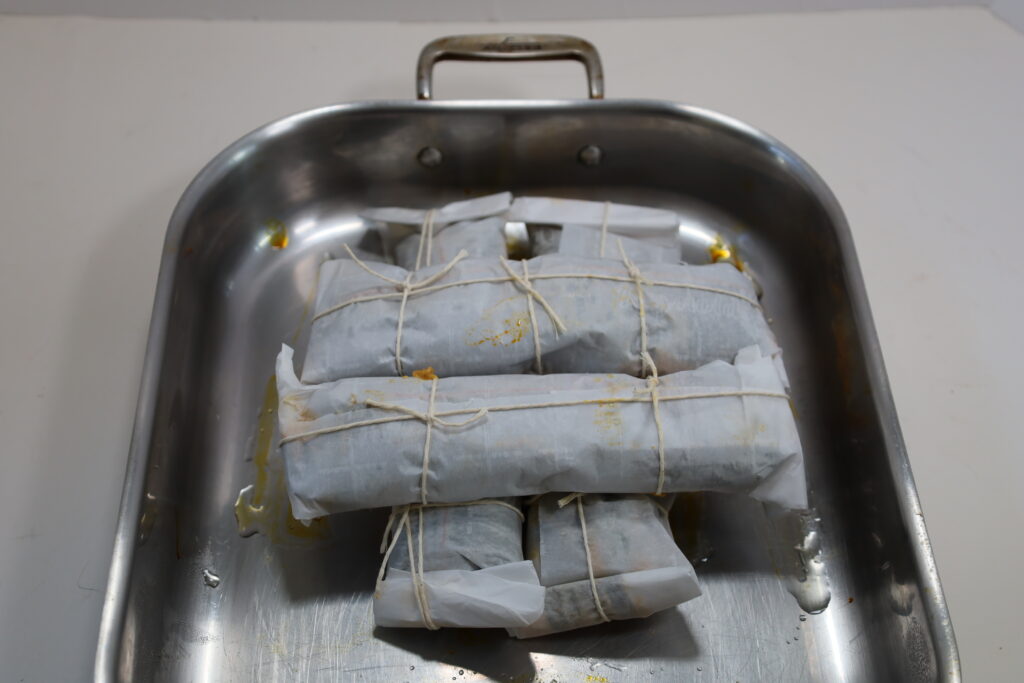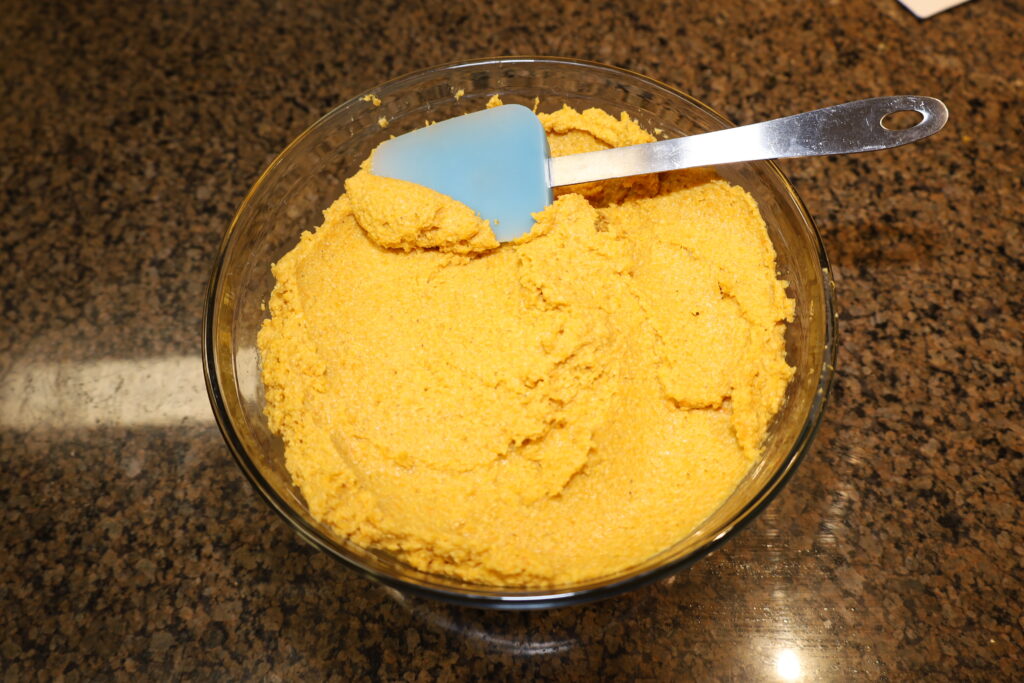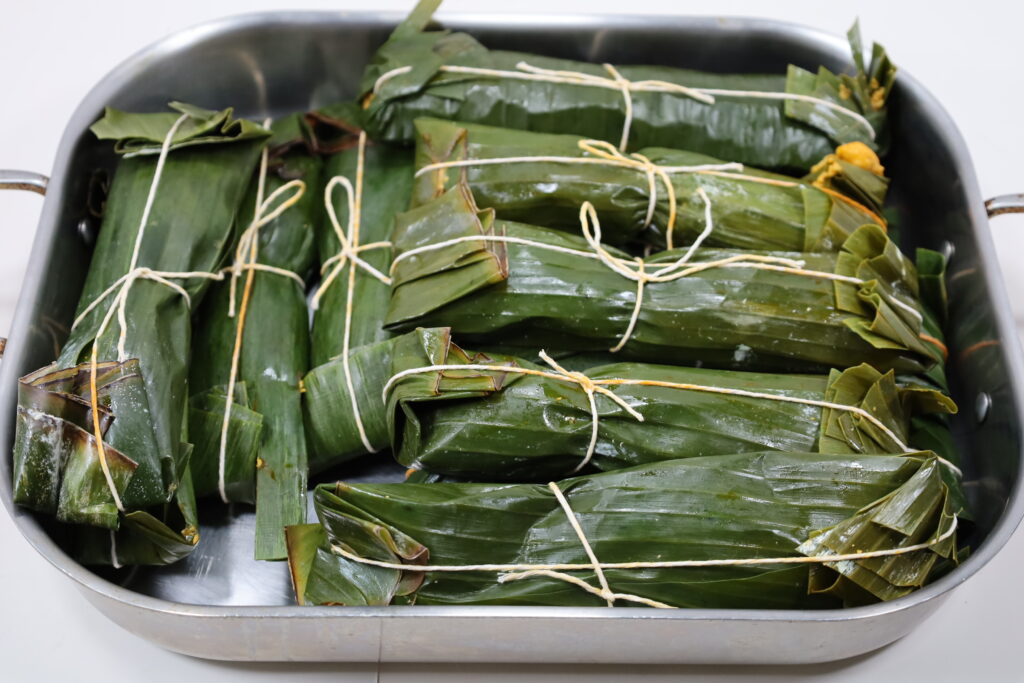The first mention of pasteles occurred in 1843 however, the first recipe in a cookbook was in the 1930s. Pasteles were influenced by the indigenous peoples of Puerto Rice, West Africa and Spain. It has been suggested that pasteles originated from the American Taino Native American tribe.
These are “tamales” for want of a better term, wrapped in banana leaves and then traditionally wrapped in parchment paper (if boiled). Since these are boiled the double wrap keeps them from being diluted by the boiling water. Pasteles however, do not contain any corn, corn meal nor masa harina. The dough recipes can be extremely varied, but frequently use green bananas alone, or with plantains, squash, malanga, yucca and many other roots or mashed “viandas”. The filling are also varied and can include pork, ham, chicken, beef, vegetables, shrimp and even fish (depending on where the pasteles is made). Additionally, raisins and olives are also added to the filling as is done traditionally in the Dominican Republic.
Pasteles are a significant investment of time and effort. However, these are delicious and the process does not need to be laborious. The work can be divided up into steps. I have outlined the steps below and have designed the recipe to incorporate these steps. These can be made over 4 or 5 days without too much trouble. But if you want a family evening of entertainment, have everyone take a step and make them in a day.
For the pasteles recipe that follows try the following steps:
Step 1: Anchioto and Sofrito: Make the Anchiote Oil and the sofrito and refrigerate. The recipe below for the sofrito produces about 4 cups. This is a fairly simple step, and once done will keep for a week or so in the refrigerator. The anchiote oil recipe produces about 2 cups of the oil, certainly enough for the following recipes.
Step 2: Pork: Cut the pork off the bone into small pieces about ~1/4 inch. Make the marinade and place in a gallon plastic bag then into a bowl. Add the meat. This needs to marinate overnnight, so just set it in the refrigerator.
Step 4: Pork Filling: Prepare and cook the filling, place it in plastic contriners and into the refrigerator.
Step 5: Dough: This is a biggest job of this project and to make things easier, make this as a single step. Set the dough in a covered bowl in the refrigerator. The dough will not keep long, so once made, plan on making the pasteles the next day, no more than 2 days later. I like a “tamale” that is firmer than the recipes I have seen on-line. My Pasteles came out fairly typical, but were still a little mushy. So I have elected to add corn starch to the dough to firm up these packets of wonder. I know this is not classic, but I believe it doesn’t affect the taste, and actually makes the mouth feel and texture much better.
Step 6: Assembly: Cut the banana leaves and soften, then fill with the dough and the filling. Wrap and tie the banana leaves. If you are going to boil the pasteles, wrap the banana tamales in parchment paper, tying them as well. Regardless, place them in the refrigerator over night.
Step 7: Cooking: Boil or steam the Pasteles. You can then serve or freeze. I prefer steaming as it doesn’t dilute the taste of a dish. Further, you don’t have to double wrap the banana leaves in parchment paper. I think steaming is gentler on the ingredients and easier on the cook, although admittedly not classic. Pasteles can be a little mushy. To combat this you can use corn starch as I have mentioned above. Also, you can steam for 60-90 minutes, if not firmed up, place them in the oven at 300 degrees for 30+ minutes. Obviously this is not classic, but it works, however be careful not to overbake these. The oven just dries the dough out a bit more, but watch them carefully.

Step 1: Anchiote Oil
Ingredients
- 2 cups Canola oil or other vegetable oil
- ¼ cup Annatto seeds
Instructions
- Place the annatto seeds in the oil in a pan over moderate low heat.
- Simmer the oil until a deep red color, then turn off the heat and set aside to cool.
- Using a fine mesh strainer, strain the seeds from the oil.
- Place the oil in a Bell jar or similar container and place in the refrigerator.
Step 1: Puerto Rican Sofrito
Ingredients
- ½ cup Cilantro, roughly chop leaves and steams. If you can find Culantro, use ½ & ½ with cilantro.
- ¼ cup pitted green olives and roughly chopped
- 1 TBPS Capers drained
- 2 White Onions chopped roughly
- 6-8 Garlic cloves roughly chopped
- ½ lb Red Bell pepper roughly chopped
Instructions
- Place the cilantro (and culantro), olives, capers, onions, garlic, and bell pepper in the bowl of a food processor.
- Process until the mixture is of an applesauce consistency.

Anchiote Oil and Butternut Squash

(after overnight in the refrigerator)
Further steps will be indicated in the following recipe.
Pasteles – Puerto Rico
Ingredients
Step 2: Pork Shoulder
- 3 Pounds Bone-in Pork Shoulder
- ¼ cup Freshlly made Sofrito
- ½ cup White Wine Vinegar
- 1 TBPS Sazon Seasoning
- 1 TBPS Adobo Seasoning
- 2 TBPS EVOO
- 2 tsp Oregano-Mexican
- 1 tsp Freshly ground black pepper
- 5-6 Garlic cloves roughly minced
Step 3: Pork Broth
- 1 Pork shoulder bone
- ½ Vidalia, yellow or sweet onion roughly chopped
- 8-10 black peppercorns
- 3 Garlic cloves roughly chopped
- 2 bay leaves
- 1 tsp Sea salt
Step 4: Pork Filling
- 2 TBPS Leaf Lard
- ½ Vidalia, sweet or yellow onion finely diced
- ¼ cup Freshly made Sofrito
- 8 ounces Tomato sauce pure without seasonings. Marzano tomatoes works well.
- 10 Black (or green) olives sliced
- ½ tsp Sea Salt
- ½ tsp Ground black papper
- 1 TBPS Capers rinsed
- 2 Bay leaves
- ½-1 Jalapeno finely chopped
Step 5: Dough
- 8 Very Green bananas These must be green, no yellow. Find these at your local Latin grocery, or look for green bananas at your grocers, but make sure they are green.
- 2 Plantains, green
- 1 Russet Potato
- 1 pound Kabocha Squash (or Butternut squash as an alternative)
- 2 pounds Malanga
- ¼ cup Anchiote Oil
- 2 TBPS Whole milk
- 2 tsp sea salt
- 2 TBPS Corn Starch
Step 6: Assembly
- Banana leaves cut into roughly 7 x 8 inch rectangles. Prepare the banana leaves as per the blog on this site: https://wrapitupfood.com/banana-leaves/
- Anchiot Oil (with a bruch)
- 1 Cup Manzanilla olives sliced in half Enough for 2 olives per pastele
- 1 Cup Roasted red peppers cut into strips Enough for 2 strips per pastele
- Cotton Twine
Step 7: Cooking
Instructions
Step 2: Pork Shoulder
- With a sharp boning knife, remove the meat from the shoulder and remove as much fat as possible.
- Cut the meat up into small pieces about ¼ inch size. Once you have the meat off the bone, set aside the bone. Also discard the fat. You can preserve this fat and use it when you cook the filling, but I prefer Leaf lard.
- In a gallon sealable plastic bag add the meat, sofrito, vinegar, sazonm, adobo, EVOO, oregano, black pepper, onion, and garlic. Place the plastic bag in a bowl and into the refrigerator overnight.
Step 3: Pork Broth
- In a 4 quart pot, place the bone, onion, black peppercorns, garlic, bay leaves and salt. Fill with water just enough to cover the bone.
- Bring to a boil and then simmer for 30-60 minutes. Skim off the foam, and reduce down the liquid by at least 1/3. Turn off the heat.
- In a fine mesh strainer, strain the broth.
- Once achieved turn off the heat, set aside until cool, then place in a plastic container in the refrigerator.
Step 4: Pork Filling
- Place the leaf lard in a Dutch Oven and heat over moderate low to moderate heat.
- When the lard is melted and hot, add the onion and cook until fragrant, then add the sofrito. Stir frequently.
- Once the sofrito is hot add the marinated pork. Cook until the pork begins to brown. Then add salt, pepper, tomato sauce, olives, capers, bay leaves, and jalapenos.
- Cook until all is well bubbling, then reduce the heat and simmer until the filling is a very thick consistency. If too watery, you can add a little corn starch.
- Once the filling is well cooked and the correct consistenty, place in plastic containers and into the refrigerator.
Step 5: Dough
- Place the green bananas and plantains in water and bring to a boil. Boil until they are softened. Once softened, remove the skins and slice into chunks.
- Peel the potato and cut up into cubes.
- Peel the butternut squash, scoop out the seeds and slice 1 pound of cubes.
- Peel the malanga, cutting off any parts that are browned. Cut into rough cubes.
- Using a food processor and the grating attachment, grate the potato, squash, and malanga. You will need a large bowl to hold all of the grattings. It will appear you have way too much, but do not fret, this all shrinks down to a manageable amount.
- Grate the bananas and plantains in the food processor. Then removew the bananas, place in the regular processor knife and process further.. This will be a bit sticky, so immediately immerse in water, or just immediately wash the slicer and bowl.
- Take the grated vegetables and place them in batches in a foor processor. Process until you have a somewhat smooth mixture. Place this mixture into another bowl.
- To the processed vegetable mixture, add the bananas, anchiote oil, broth, milk, adobo, salt and corn starch (see note). Mix very well by hand. This is the best way to make sure all the ingredients are well mixed and incorporated. Remove any large pieces, you can re process or discard.
- Once well mixed, cover and set into the refrigerator. Some slight darkening will occur overnight, but just remix this your hands the next day, the color will be fine. It darkens on cooking anyway.
Step 6: Assembly
- Take the cut cleaned banana leaves and place in boiling water until pliable. Be careful not to boil them too long. 5-10 minutes is plenty. Remove and place on a clean flat surface.
- Cut the spine from the leaf, and place the leaf with the veins running to the right and left.
- Paint the leaf, using the pastry brush, with the Anchiote oil.
- Place ~ ½ cup of the dough on the leaf, and flatten it out. Place it towards the end of the leaf closest to you.
- Place ~ ¼ cup of the filling on top of the dough. Smooth and even it out.
- Place 2 strips of the roasted red pepper and 4 olive halves on top of the filling.
- Then place about 1/8th cup of the dough on top of the filling.
- Very carefully, roll the banana leaf, so that the dough covers the filling. Then roll the leaf up into a tube. Fold both ends over, then tie with cotton twine (see picture above).
- Place all the finished Pasteles in a platter, cover with plastic wrap and place in the refrigerator overnight.
Step 7: Steaming or Boiling
- If you are going to boil these, then wrap them again in parchment paper. However, I find steaming is gentler, and doesn't dilute the pastele. You also don't have to wrap them in the parchment paper.
- Using a steamer pot, place the prepared pasteles, and stem them for ~ 45-60 minutes. Remove one pastele after 45 minutes, open and test to see if it is completely cooked.
- These can then be frozen or served. If frozen, just resteam them and serve. Freeze them in vacuum packed bags.
Pasteles Notes:
- The Adobo spice blend I use can be found on Amazon.
- Place the assembled pasteles in the refrigerator overnight and then cook them. This was a recommendation from a Puerto Rican friend who was adamant that this makes for a better outcome as the dough firms up in the refrigerator.
- Use your hands to mix the dough. There is really no other way to do this that makes a uniform dough.
- The dough may discolor mildly overnight, but just remix with your hands and the color will be fine. But try to use it up with 24 hours, at most 48 hours.
- I add corn starch, since I prefer a firmer Pastele. I have not been able to get this firmness, similar to a regular Mexican tamale, using the typical recipe without corn starch. But if you don’t mind a little mushiness, these still taste great.
- Banana leaves take care, patience and preparation. See my blog on banana leaves.
- The green bananas and plantains are very sticky and will gum up your utensils. Once you are done processing the bananas, soak them in soapy hot water and clean carefully.
- Since I do so much steaming, I use a large 3 tiered steamer pot, which is actually not that expensive. If you plan on making dumplings, and the various dishes on my site, you might think about investing in a similar utensil.
- You can serve pasteles with Puerto Rican Potato Salad (delicious), or Pique cirollo (Puerto Rican hot sauce), arroz con grandules (wonderful), or escabeche (a Puerto Rican green banana “salad”).









1 Comment